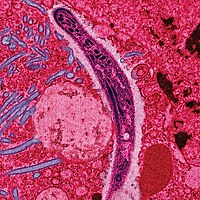
Photo from wikipedia
BackgroundMalaria is a major mosquito transmitted, blood-borne parasitic disease that afflicts humans. The disease causes anaemia and other clinical complications, which can lead to death. Plasmodium vivax is known for… Click to show full abstract
BackgroundMalaria is a major mosquito transmitted, blood-borne parasitic disease that afflicts humans. The disease causes anaemia and other clinical complications, which can lead to death. Plasmodium vivax is known for its reticulocyte host cell specificity, but many gaps in disease details remain. Much less is known about the closely related species, Plasmodium cynomolgi, although it is naturally acquired and causes zoonotic malaria. Here, a computational model is developed based on longitudinal analyses of P. cynomolgi infections in nonhuman primates to investigate the erythrocyte dynamics that is pertinent to understanding both P. cynomolgi and P. vivax malaria in humans.MethodsA cohort of five P. cynomolgi infected Rhesus macaques (Macaca mulatta) is studied, with individuals exhibiting a plethora of clinical outcomes, including varying levels of anaemia. A discrete recursive model with age structure is developed to replicate the dynamics of P. cynomolgi blood-stage infections. The model allows for parasitic reticulocyte preference and assumes an age preference among the mature RBCs. RBC senescence is modelled using a hazard function, according to which RBCs have a mean lifespan of 98 ± 21 days.ResultsBased on in vivo data from three cohorts of macaques, the computational model is used to characterize the reticulocyte lifespan in circulation as 24 ± 5 h (n = 15) and the rate of RBC production as 2727 ± 209 cells/h/µL (n = 15). Analysis of the host responses reveals a pre-patency increase in the number of reticulocytes. It also allows the quantification of RBC removal through the bystander effect.ConclusionsThe evident pre-patency increase in reticulocytes is due to a shift towards the release of younger reticulocytes, which could result from a parasite-induced factor meant to increase reticulocyte availability and satisfy the parasite’s tropism, which has an average value of 32:1 in this cohort. The number of RBCs lost due to the bystander effect relative to infection-induced RBC losses is 62% for P. cynomolgi infections, which is substantially lower than the value of 95% previously determined for another simian species, Plasmodium coatneyi.
Journal Title: Malaria Journal
Year Published: 2018
Link to full text (if available)
Share on Social Media: Sign Up to like & get
recommendations!